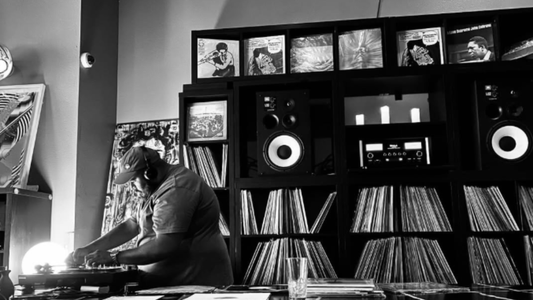
Jean-Michel Jarre – Oxygène (1976)
A six-part symphony of breath and light. Rafi Mercer on the art of listening as wonder.
By Rafi Mercer
Some albums don’t simply play — they breathe. Jean-Michel Jarre’s Oxygène, released in 1976, was one of those rare records that seemed to inhale the future and exhale wonder. For many listeners, it was the first time electronic sound felt truly alive — not as machinery, but as atmosphere. Nearly half a century later, on a good sound system, it still fills the room like weather.
Jarre made Oxygène in a small Paris apartment using little more than tape recorders, early synthesizers, and imagination. There was no digital interface, no computer sequencing — just instinct, voltage, and time. What emerged was a six-part suite that behaves less like a collection of tracks and more like a single, continuous pulse.

“Oxygène (Part I)” begins almost inaudibly — a shimmer, a faint drone, a world forming out of static. Then the melody arrives: slow, patient, suspended between melancholy and awe. Through speakers with real depth, you can hear the oxygen of the title — the air between sounds, the faint tape hiss that carries warmth like breath. It’s a sonic landscape where every tone has texture.
By “Part II,” the rhythm awakens. Synths swirl in counterpoint; arpeggios drift like tides. It’s electronic music that feels organic, oceanic — not cold, but tidal. Jarre wasn’t designing beats; he was composing space. The track still sounds extraordinary in a listening bar. The low frequencies roll like mist across the floor, while the high notes flicker like light on glass.
There’s something strangely human about the whole record. Even without vocals, you sense voice everywhere — yearning, curious, reflective. Oxygène doesn’t describe technology; it describes emotion through technology. In 1976 that was radical. Where Kraftwerk moved toward automation, Jarre leaned toward atmosphere.
Play Oxygène on a proper home system and it becomes architecture. The stereo field stretches wide; layers orbit gently; reverbs bloom like cathedral vaults. “Part IV” — the most famous movement — remains hypnotic. Its looping melody feels eternal, both grounded and celestial, a piece of cosmic pop that somehow carries the weight of classical structure. It’s easy to forget how handmade it was: each oscillator adjusted manually, every sweep the result of touch.
Later sections descend into abstraction — “Part V” moving toward ambient stillness, “Part VI” resolving like dawn after a long night. By the end, the listener feels suspended between breath and silence, as though the record itself were exhaling.
What fascinates me is how Oxygène continues to reward attention. It’s not nostalgic; it’s timeless. Its patience invites you to slow down, to hear detail most music hides — the decay of notes, the ghost harmonics between frequencies. In a listening bar, it transforms the air. People stop talking. You feel it as much as hear it.
And perhaps that’s the point: Jarre wasn’t just composing sound; he was teaching how to listen. The album’s title isn’t poetic accident — it’s literal. It gives you space to breathe.
Few will ever truly hear this record the way it deserves — through clean amplification, in stillness, with focus. But those who do know how extraordinary it is. It’s proof that electronic music, when made with care and curiosity, can feel more human than any voice.
Oxygène remains an invitation — to slow down, to breathe differently, to rediscover wonder in vibration.
Rafi Mercer writes about the spaces where music matters.
For more stories from Tracks & Tales, subscribe, or click here to read more.














